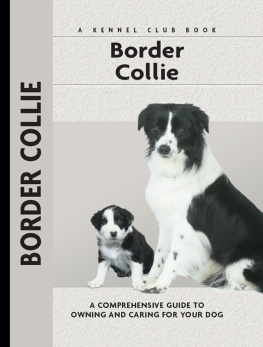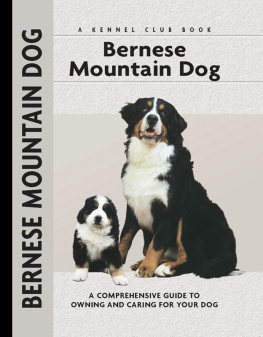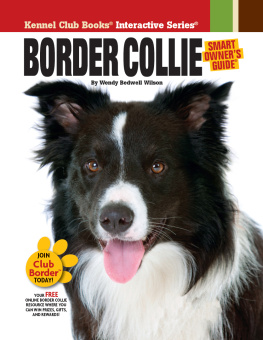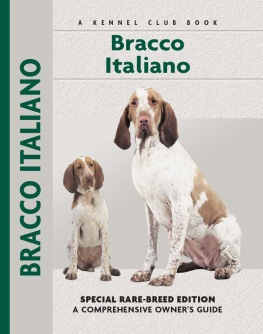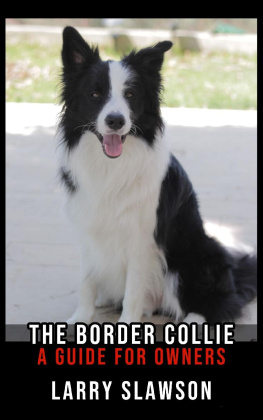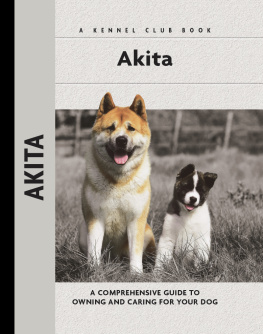Physical Characteristics of the Border Collie
(from the American Kennel Club breed standard)
Skull: Relatively flat and moderate in width. The skull and muzzle are approximately equal in length. In profile the top of the skull is parallel with the top of the muzzle.
Muzzle: Strong, tapering slightly to the nose. The underjaw is strong and well developed.
Eyes: Set well apart, of moderate size, oval in shape. The color encompasses the full range of brown eyes; dogs having body colors other than black may have noticeably lighter eye color.
Nose: Color matches the primary body color. Nostrils are well developed.
Ears: Of medium size, set well apart, one or both carried erect and/or semi-erect (varying from to of the ear erect).
Neck: Of proportional length to the body, strong and muscular, slightly arched and blending smoothly into the shoulders.
Chest: Deep, moderately broad, reaching no further than the point of the elbow.
Loins: Moderately deep and short, muscular, slightly arched and with a slight but distinct tuck up.
Forequarters: Parallel when viewed from front, pasterns slightly sloping when viewed from side. The shoulder blades are long, well laid back and well-angulated to the upper arm. Shoulder blades and upper arms are equal in length.
Feet: Compact, oval in shape; pads deep and strong, toes moderately arched and close together with strong nails of moderate length. Dewclaws may be removed.

Topline: Back is level from behind the withers to the slightly arched, muscular loins, falling to a gently sloping croup.
Tail: Set on low and moderately long with the bone reaching at least to the hock. The ideal tail carriage is low when the dog is concentrating on a given task and may have a slight upward swirl at the end like a shepherds crook.
Hindquarters: Broad and muscular, in profile sloping gracefully to the low set tail. The thighs are long, broad, deep and muscular. Stifles are well turned with strong hocks that may be either parallel or very slightly turned in. Dewclaws should be removed. Feet, although slightly smaller, are the same as front.
Coat: Two varieties are permissible, both having close-fitting, dense, weather resistant double coats with the top coat either straight or wavy and coarser in texture than the undercoat which is soft, short and dense.
Color: All colors or combination of colors and/or markings.
Size: The height at the withers varies from 19 to 22 inches for males, 18 to 21 inches for females.

Contents

Trace the beginnings of the Border Collie as a herding dog along the Welsh and Scottish borders of England and follow its spread in popularity around the world as a working sheepdog, companion dog, show dog, competition dog and ambassador of canine goodwill.

Define those traits about the Border Collie that make him unique: his working prowess, superior intelligence, desire to please and succeed and his natural aptitude for work. Such a gifted dog can make the right owner a great pet!

Learn the requirements of a well-bred Border Collie by studying the description of the breed set forth in the American Kennel Club standard. Both show dogs and pets must possess key characteristics as outlined in the breed standard.

Find out about how to locate a well-bred Border Collie puppy. Discover which questions to ask the breeder and what to expect when visiting the litter. Prepare for your puppy shopping spree. Also discussed are home safety, the first trip to the vet and socialization.

Cover the specifics of taking care of your Border Collie every day: feeding for the puppy, adult and working dog; grooming, including coat care, ears, nails, teeth and bathing; and exercise needs for your dog. Also discussed are the essentials of dog identification and traveling.

Begin with the basics of training the puppy and adult dog. Learn the principles of house-training the Border Collie, including the use of crates and basic scent instincts. Enter your Border Collie in Puppy Kindergarten and introduce the pup to his collar and leash and progress to the basic commands. Find out about obedience classes and other activities.

By Lowell Ackerman DVM, DACVD
Become your dogs healthcare advocate and a well-educated canine keeper. Select a skilled and able veterinarian. Discuss pet insurance, vaccinations and infectious diseases, the neuter/spay decision and a sensible, effective plan for parasite control, including fleas, ticks and worms.

Know when to consider your Border Collie a senior and what special needs he will have. Learn to recognize the signs of aging in terms of physical and behavioral traits and what your vet can do to optimize your dogs golden years.

Step into the center ring and find out about the world of showing pure-bred dogs. Heres how to get started in shows, how they are organized and whats required for your dog to become a champion. Take a leap into the realms of obedience trials, agility and herding events.

Analyze the canine mind to understand what makes your Border Collie tick. The following potential problems are addressed: aggression, separation anxiety, sexual misconduct, chewing, digging, jumping up and barking.
KENNEL CLUB BOOKS BORDER COLLIE
ISBN 13: 978-1-59378-211-5
Copyright 2005 Kennel Club Books An Imprint of I-5 Press A Division of I-5 Publishing, LLC
3 Burroughs, Irvine, CA 92618 USA
Cover Design Patented: US 6,435,559 B2 Printed in China
All rights reserved. No part of this book may be reproduced in any form, by photostat, scanner, microfilm, xerography or any other means, or incorporated into any information retrieval system, electronic or mechanical, without the written permission of the copyright owner.
14 13 12 11 10 6 7 8 9 10
Photography by
Paulette Braun, T.J. Calhoun, Alan and Sandy Carey Kent and Donna Dannen, Isabelle Franais, Carol Ann Johnson, Bill Jonas, Nancy Liguori, John S. Muzyka, Tam C. Nguyen and Karen Taylor.
Illustrations by Patricia Peters.

The Border Collie has been called the most intelligent dog in the world. He can be a wonderful pet, guardian and loyal friend.


